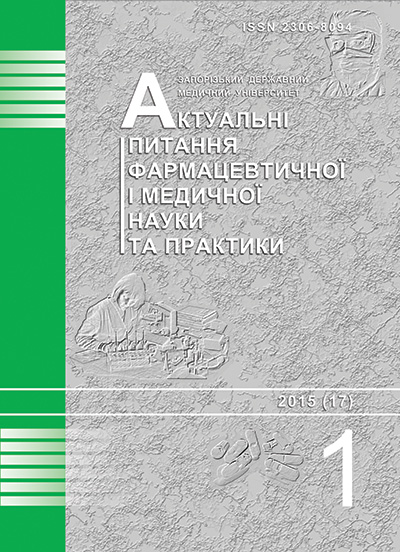SPECTROPHOTOMETRIC DETERMINATION OF ATORVASTATINE CALCIUM
DOI:
https://doi.org/10.14739/2409-2932.2015.1.41370Keywords:
Analysis, Spectrophotometry, Cholesterol, Bromcresol PurpleAbstract
Atorvastatin Calcium reduces the level of cholesterol and lipoproteins in blood plasma, inhibits cholesterol synthesis in liver, increasing the number of low-density lipoproteins. It also reduces cholesterol in patients with homozygous familial hypercholesterolemia, which is usually resistant to lipid-lowering therapy. In today's world physical and chemical methods of analysis,including absorption spectrophotometry in the visible spectrum, which is characterized by ease of performance, availability, accuracy and selectivity,playsleadership role in quality assurance of medicines,
The aim of research was the development of highly sensitive, simple and valid spectrophotometric methods of atorvastatin calcium tablets determination based on reaction with bromocresol purple (BCP). To achieve this goal the following objectives have been set:
- determine the optimal conditions for the photometric response of atorvastatin calcium BCP and calculate analytical performance sensitivity reactions;
- install coefficients stoichiometric ratio "atorvastatin- BCP";
- develop techniques for the quantitative determination of atorvastatin calcium tablets;
- conduct the validation of the developed techniques.
When choosing solvent solubility of atorvastatin calcium and BCP, and maximum optical density obtained solutionwere taken into account. Experimentally, it was found that atorvastatin calcium interacts with BCP in acetone medium to form a colored product with a maximum at 399 nm in absorbance. The value of molar absorbance coefficient is 3.8*103, which indicates high sensitivity of reactions.
To check the accuracy of the proposed methods,they were validated by key characteristics, namely, linearity, precision, accuracy and robustness.
The results processed by least squares methods show linearity over the entire range of its application.
Precision was determined at the level of convergence.
Accuracy was established by additives method.
Evaluation of robustness was conducted by identifying factors that affect the value of the optical density - namely, the number of added reagents.
Conclusions:
1. It has been established that atorvastatin calcium interacts with BCP at room temperature in acetone medium. The investigated reaction is high: the molar absorption coefficient is3.8*103.
2. It has been found that atorvastatin calcium and BCP react in the ratio 1: 1, by the molar ratiomethod and by the continuous changes.
3 The method of spectrophotometric assay of atorvastatin calcium tablets from different manufacturers has been developed.
4 The developed method has been proved in the following validation characteristics as linearity, precision, accuracy and robustness.
References
Mashkovskij, M. D. (2000). Lekarstvennye sredstva [Medicines]. (Vol. 2). Moscow. [in Russian].
Skorda, D., & Kontoyannis, C. (2008). Identification and quantitative determination of atorvastatin calcium polymorph in tablets using FT-Raman spectroscopy. Talanta, 74(4), 1066−1070. doi: 10.1016/j.talanta.2007.07.030.
Gupta, L. (2012). Spectroscopic characterization and quantitative determination of atorvastatin calcium impurities by novel HPLC method. Spectrochimica Acta Part A: Molecular and Biomolecular Spectroscopy, 97, 495−501. doi: 10.1016/j.saa.2012.06.037.
Novakova, L, & Solich, P. (2008). HPLC methods for the determination of simvastatin and atorvastatin. TrAC Trends in Analytical Chemistry, 27(4), 352−367. doi:10.1016/j.trac.2008.01.013.
British Pharmacopeia. (2000). London, Her Majesty’s Stationery Office.
Bulatov, M. I. & Kalinkin I. P. (1986). Prakticheskoe rukovodstvo po fotometricheskim metodam analiza [Practical guide to the photometric method of analysis]. Leningrad: Khimiya. [in Russian].
Charles, J., & Parker Jr. (1993). Analytical biochemistry. Burnt Mill, Harlow, Essex, England: Longman Scientific & Technical, 108(2), 303–305.
(2008). Derzhavna Farmakopeia Ukrainy [State Ukrainian Pharmacopeia]. Kharkiv, 2. [in Ukrainian].
Downloads
How to Cite
Issue
Section
License
Authors who publish with this journal retain copyright and grant the journal right of first publication with the work simultaneously licensed under a Creative Commons Attribution License that allows others to share the work with an acknowledgement of the work's authorship and initial publication in this journal.


